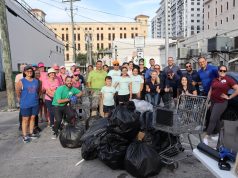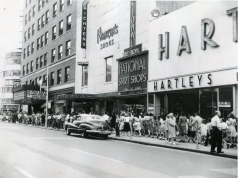On a Wednesday evening in Sunny Isles Beach last month, 11-year-old Anthony Reznik was with his stepfather and sister. As they waited at the pedestrian crosswalk on the 300 block of Sunny Isles Beach Boulevard, the light signaled that they were okay to cross. According to Miami-Dade police, a distracted driver then came barreling toward the intersection, running the red light and hitting the child. The Norman S. Edelcup sixth-grader was in the hospital in critical condition for nearly two weeks but was eventually pronounced brain dead.
The Feb. 10 incident was not an isolated one, but the most recent addition in a series of pedestrian and cyclist injuries and deaths that Sunny Isles residents say have become all too common. The tragic death of Anthony was felt heavily throughout the community, prompting residents to fight harder for safer streets. The Sunny Isles Beach Commission has heard the voices of the residents and is working toward making much-needed improvements to the city.
In a bicycle and pedestrian safety study conducted by the Miami-Dade Transportation Planning Organization, the number of bicycle and pedestrian incidents from 2008 to 2013 was shown on maps of Miami-Dade County. In the maps depicting pedestrian and bicycle crashes, Sunny Isles Beach is jam-packed with dots, each representing a crash.
Many residents weren’t aware that this was an issue until 2018, when another high-profile fatal crash shook the community.
On July 1, a family of four was walking on the sidewalk near 174th Street and Collins Avenue. They were on their way to a park when a driver lost control of his vehicle and plummeted into the family. The father, 34-year-old real estate lawyer Amir Pelleg, was pronounced dead at the scene, while his wife, Zulma Guillot Pelleg, suffered a traumatic brain injury and fell into a coma. Their two young daughters, ages 3 and 7 at the time, endured severe injuries.
Johana Rabinovich, 37, remembers Pelleg’s death clearly. She has been a Sunny Isles resident for over 10 years now and has two children, ages 4 and 6. She says that after Pelleg died she realized that she needed to speak up. Through her Facebook group, Sunny Isles Beach Moms, she connected with other concerned mothers.
Soon enough, a group of about 15 Sunny Isles women had come together to bring their pleas to city hall. At the next commission meeting following the accident, Rabinovich presented a petition to the commission members, which had garnered almost 2,500 signatures. The petition asked the city to take action toward making Sunny Isles Beach safer for pedestrians. Sadly, Rabinovich says, nothing has really changed.
“Our government officials’ stance has been sad,” Rabinovich said. “It’s always been, ‘Well, accidents happen, you know?’ And yes, accidents happen but what are you going to do to make it somewhat safer? We need to invest into the future of what we want this city to become; we can’t just be a city of billionaires with high-end high-rises where you can’t walk a block because it’s so unsafe.”
Several more accidents occurred after 2018, with some resulting in fatalities. Just last April, a 17-year-old boy was killed. Sholem Benchimol, a soccer player at Scheck Hillel Community School, was riding his bike at the intersection of Collins Avenue and 172nd Street when a car rammed into him. Benchimol was the son of Jose Benchimol, a well-known rabbi at Beit Rambam Congregation.
Last month’s tragedy seemed to be the last straw for many residents, who feel as if these crashes have become normal. This sentiment echoes through the Facebook group Sunny Isles Beach Insider, which is also run by Rabinovich.
“I’m outraged!” one member, Inna Shef, commented on a Facebook post in the group. “We’ve talked about this again and again. [I] spoke to the Vice Mayor this time last year. She said she’ll talk to the Chief of Police about the issue of road safety… and nothing!”
A community memorial, which doubled as a “stand for traffic and pedestrian safety,” was held on March 7 in Anthony’s honor. The event was organized by a group of residents and was approved by Anthony’s family. The attendees hoped that it would bring awareness to the ongoing pedestrian safety problem.
“Hopefully with his name, a lot of fixing will happen in the city where we live, because the city where we live has a lot of families, little kids,” Inna Trakhtenburg, Anthony’s mother, said to WSVN following his death.
A petition was also created to change the name of Sunny Isles Beach Boulevard to Anthony Reznik Boulevard. It has already received over 3,500 signatures.
The residents in the Facebook group have not been shy about expressing their own ideas to improve pedestrian safety. Increasing police presence has been a popular suggestion. Other ideas include brighter street lights, wider sidewalks, bollards, protected bike lanes, speed bumps and red light cameras.
The city commission has inquired about what can be done at the state level. The day after Anthony was hit, they contacted the Florida Department of Transportation to review the pedestrian walkway at Sunny Isles Beach Boulevard and State Road 826. James Wolfe, District Six Secretary of FDOT, responded to the city’s request via email.
Wolfe declined an interview request, but his office provided his response to the commission inquiry.
“It is particularly tragic that the collision should have been easily avoided,” he wrote in the email. “The pedestrian signal was working as intended. The crash was caused by a driver that ran the red light.”
Wolfe also listed several projects that FDOT will take on to better pedestrian safety, including: additional streetlights at the crosswalk, adding “PED XING AHEAD” pavement markings, and teaming up with the city’s police department to implement an education and enforcement campaign.
As for solutions at the city level, Vice Mayor Larissa Svechin said that most of it is out of their control. However, there are some changes that are being carried out. Starting Feb. 26 and lasting until May 14, there will be “high visibility enforcement” conducted by Sunny Isles Beach police on Collins Avenue. They will also increase their enforcement citywide.
Additionally, the city is undertaking the construction of two pedestrian bridges. One, called the Government Center Pedestrian Bridge, will be built at 180th Street and Collins Avenue. The second, the 174th Street Pedestrian Bridge, will be sprung up at 174th Street and Collins Avenue.
City Manager Chris Russo says that the 180th Street bridge has 90% of its plans complete, with construction possibly beginning by the end of this year. The 174th Street bridge will require some more time, however, as it is a much larger project. It will aim to mimic Manhattan’s High Line, functioning as a bridge and park for residents to enjoy. The cost is an estimated $13 million, according to Russo.
Some residents such as Tony Schneider are welcoming the idea.
“It would be amazing. Less accidents, no waiting for the traffic signal, great… exercise, less traffic jams [and a] good looking structure,” he wrote on the Sunny Isles Beach Insider group.
Others are not as convinced. Rabinovich argues that the budget for the expensive bridges should go toward more ambitious efforts.
“The answer is not bridges,” she said. “I wish that we would [instead] invest the multimillion dollars in creating safer streets from north to south. If you’re [building] these bridges to make it safer for pedestrians, how is that safe for the person that lives on 190th Street that still has to walk south to get to one of the bridges?”
Svechin is aware of residents’ frustrations and has acknowledged their ideas as “good suggestions.” She hopes to mobilize some of these proposals as the city moves forward in building a safer, pedestrian-friendly community.
“We are actively working on improving the safety of our roads for our pedestrians,” she said. “Because that’s our goal, we want people to be walking around, we want to alleviate traffic… It has to be a combination of road design and educating the residents, drivers and legislators so they understand what we’re dealing with… There’s a lot of variables here but it doesn’t mean that we’re going to stop.”
































